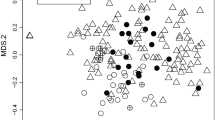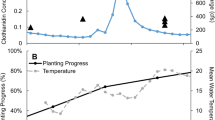Abstract
Anthropogenic chemical contamination is an important issue for conservation of aquatic ecosystems. While recent research highlights that community context can mediate the consequences of contaminant exposure, little is known about how contaminants themselves might determine this context by altering habitat selection and thus initial community composition. Here we show that the insecticide carbaryl and its commercial counterpart Sevin can affect aquatic community composition by differentially altering oviposition and colonization of experimental pools by amphibians and insects. On average, contaminated pools received 20-fold more adult beetle and heteropteran colonists and 12-fold more Culex mosquito and chironomid midge egg masses. On the other hand, ovipositing Anopheles mosquitoes and cricket frogs showed no preference and we have shown previously that gray treefrogs strongly avoid contaminated pools. Overall, initial richness doubled in contaminated pools compared with controls. By affecting colonizing taxa differently and increasing richness, the contaminant may alter the ecological context under which subsequent effects of exposure will unfold. Given that community context is important for evaluating toxicity effects, understanding the net effects of contaminants in natural systems requires an understanding of their effects on community assembly via shifts in habitat selection.



Similar content being viewed by others
References
Battin J (2004) When good animals love bad habitats: ecological traps and the conservation of animal populations. Conserv Biol 18:1482–1491
Binckley CA, Resetarits WJ (2005) Habitat selection determines abundance, richness and species composition of beetles in aquatic communities. Biol Lett 1:370–374
Boone MD, Semlitsch RD (2001) Interactions of an insecticide with larval density and predation in experimental amphibian communities. Conserv Biol 15:228–238
Boone MD, Semlitsch RD (2002) Interactions of an insecticide with competition and pond drying in amphibian communities. Ecol Appl 12:307–316
Boone MD, Semlitsch RD (2003) Interactions of bullfrog tadpole predators and an insecticide: predation release and facilitation. Oecologia 137:610–616
Boone MD, Bridges CM, Rothermel BB (2001) Growth and development of larval green frogs (Rana clamitans) exposed to multiple doses of an insecticide. Oecologia 129:518–524
Boone MD, Semlitsch RD, Fairchild JF, Rothermel BB (2004) Effects of an insecticide on amphibians in large-scale experimental ponds. Ecol Appl 14:685–691
Chesson J (1984) Effect of Notonecta (Hemiptera: Notonectidae) on mosquitoes (Diptera: Culicidae): predation or selective oviposition? Environ Entomol 13:531–538
DA US (1989) Insecticide background statement. In: U.S. Department of Agriculture Handbook no. 685. U.S. Department of Agriculture, Beltsville, MD
Davidson C (2004) Declining downwind: amphibian population declines in California and historical pesticide use. Ecol Appl 14:1892–1902
Davidson C, Shaffer HB, Jennings MR (2002) Spatial tests of the pesticide drift, habitat destruction, UV-B, and climate-change hypotheses for California amphibian declines. Conserv Biol 16:1588–1601
de Noyelles F, Dewey SL, Huggins DG, Kettle WD (1994) Aquatic mesocosms in ecological effects testing: detecting direct and indirect effects of pesticides. In: Graney RL, Kennedy JH, Rodgers JH Jr (eds) Aquatic mesocosm studies in ecological risk assessment. Lewis, Boca Raton, FL, pp 577–603
Delibes M, Ferreras P, Gaona P (2001a) Attractive sinks, or how individual behavioral decisions determine source-sink dynamics. Ecol Lett 4:401–403
Delibes M, Gaona P, Ferreras P (2001b) Effects of an attractive sink leading into maladaptive habitat selection. Am Nat 158:277–285
Derraik JGB, Closs GP, Dickinson KJM, Sirvid P, Barratt BIP, Patrick BH (2002) Arthropod morphospecies versus taxonomic species: a case study with Araneae, Coleoptera, and Lepidoptera. Conserv Biol 16:1015–1023
Edwards CA (1973) Environmental pollution by pesticides. Plenum, New York
Fleeger JW, Carman KR, Nisbet RM (2003) Indirect effects on contaminants in aquatic ecosystems. Sci Total Environ 317:207–233
Garcia EA (2006) Regional coexistence and local dominance in Chaoborus: species sorting along a predator gradient. In: Department of Zoology, vol PhD, Michigan State University, East Lansing, p 65
Gotelli NJ, Kelly WG (1993) A general model of metapopulation dynamics. Oikos 68:210–221
Hanski IA, Gilpin ME (1997) Metapopulation biology: ecology. Genetics and Evolution. Academic Press, San Diego, CA
Hayes TB et al (2002) Hermaphroditic, demasculinized frogs after exposure to the herbicide atrazine at low ecologically relevant doses. Proc Natl Acad Sci USA 99:5476–5480
Holyoak M, Leibold MA, Holt RD (2005) Metacommunities: spatial dynamics and ecological communities. The University of Chicago Press, Chicago, IL
Horvath G, Zeil J (1996) Kuwait oil lakes as insect traps. Nature 379:303–304
Johnson PTJ et al (2007) Aquatic eutrophication promotes pathogenic infection in amphibians. Proc Natl Acad Sci USA 104:15781–15786
Kats LB, Sih A (1992) Oviposition site selection and avoidance of fish by streamside salamanders (Ambystoma barbouri). Copeia 1992:468–473
Kiesecker JM (2002) Synergism between trematode infection and pesticide exposure: a link to amphibian deformities in nature? Proc Natl Acad Sci 99:9900–9904
Kreutzweiser DP, Back RC, Sutton TM, Thompson DG, Scarr TA (2002) Community-level disruptions among zooplankton of pond mesocosms treated with neean (azadirachtin) insecticide. Aqua Toxicol 2002:257–431
Kriska G, Horvath G, Andrikovics S (1998) Why do mayflies lay their eggs en masse on dry asphalt roads? Water-imitating polarized light reflected from asphalt attracts Ephemeroptera. J Exp Biol 201:2273–2286
Kristan WB (2003) The role of habitat selection behavior in population dynamics: source-sink systems and ecological traps. Oikos 103:457–468
Marsh DM, Borrell BJ (2001) Flexible oviposition strategies in tungara frogs and their implications for tadpole spatial distributions. Oikos 93:101–109
Merritt RW, Cummins KW (1996) An introduction to the aquatic insects of North America. Kendall and Hunt, Dubuque
Nolte U (1993) Egg masses of Chironomidae (Diptera): a review, including new observations and a preliminary key. Entomol Scand Suppl 43:1–72
Norris LA, Lorz HW, Gregory SV (1983) Influence of forest and range land management on anadromous fish in Western North America: forest chemicals. U.S. Forest Service, Portland
Parmelle JR, Knutson MG, Lyon JE (2002) A field guide to the amphibian larvae and eggs of Minnesota, Wisconsin, and Iowa. In: Information and technology report, U.S. Geological Survey, Biological Resources Division, Washington, DC, pp iv–38
Petranka JW, Fakhoury K (1991) Evidence of a chemically mediated avoidance response of ovipositing insects to blue gills and green frog tadpoles. Copeia:234–239
Pinheiro JC, Bates DM (2000) Mixed-effects models in S and S-plus. Springer, New York
Relyea RA (2003) Predator cues and pesticides: a double dose of danger for amphibians. Ecol Appl 13:1515–1521
Relyea RA (2005) The impact of insecticides and herbicides on the biodiversity and productivity of aquatic communities. Ecol Appl 15:618–627
Relyea R, Hoverman JT (2006) Assessing the ecology in ecotoxicology: a review and synthesis in freshwater systems. Ecol Lett 9:1157–1171
Relyea RA, Mills N (2001) Predator-induced stress makes the pesticide carbaryl more deadly to gray treefrog tadpoles (Hyla versicolor). Proc Natl Acad Sci USA 98:2491–2496
Relyea RA, Schoeppner NM, Hoverman JT (2005) Pesticides and amphibians: the importance of community context. Ecol Appl 15:1125–1134
Resetarits WJ, Wilbur HM (1989) Choice of oviposition site by Hyla chrysoscelis: role of predators and competitors. Ecology 70:220–228
Resetarits WJ, Binckley CA, Chalcraft DR (2005) Habitat selection, species interactions, and processes of community assembly in complex landscapes: a metacommunity perspective. In: Holyoak M, Leibold M, Holt RD (eds) Metacommunities: spatial dynamics and ecological communities. The University of Chicago Press, Chicago, pp 374–398
Robertson BA, Hutto RL (2006) A framework for understanding ecological traps and an evaluation of existing evidence. Ecology 87:1075–1085
Rohr JR, Crumrine PW (2005) Effects of an herbicide and an insecticide on pond community structure and processes. Ecol Appl 15:1135–1147
Rohr JR, Kerby J, Sih A (2006) Community ecology as a framework for predicting contaminant effects. Trends Ecol Evol 21:606–613
Rohr JR, Mahan CG, Kim KC (2007) Developing a monitoring program for invertebrates: guidelines and a case study. Conserv Biol 21:422–433
Rohr JR et al (2008) Agrochemicals increase trematode infections in a declining amphibian species. Nature 455:1235–1239
SAS (2006) The Glimmix procedure, June 2006. SAS Institute, Cary, NC http://support.sas.com/rnd/app/papers/glimmix.pdf
Schulz R, Dabrowski JM (2001) Combined effects of predatory fish and sublethal pesticide contamination on the behavior and mortality of mayfly nymphs. Environ Toxicol Chem 20:2537–2543
Semlitsch RD, Bridges CM, Welch AM (2000) Genetic variation and a fitness tradeoff in the tolerance of gray treefrog (Hyla versicolor) tadpoles to the insecticide carbaryl. Oecologia 125:179–185
Shulman RS, Chase JM (2007) Increasing isolation reduces predator: prey species richness ratios in aquatic food webs. Oikos 116:1581–1587
Sibley PK, Kaushik NK, Kreutzweiser DP (1991) Impact of a pulse application of permethrin on the macroinvertebrate community of a headwater stream. Environ Pollut 70:35–55
Spieler M, Linsenmair KE (1997) Choice of optimal oviposition sites by Hoplobatrachus occipitalis (Anura: Ranidae) in an unpredictable and patchy environment. Oecologia 109:184199
Takahashi M (2007) Oviposition site selection: pesticide avoidance by gray treefrogs. Environ Toxicol Chem 26:1476–1480
Venables WN, Ripley BD (2002) Modern applied statistics with S, 4th edn. Springer, New York
Ver Hoef JM, Boveng PL (2007) Quasi-poisson vs. negative bionomial regression: how should we model overdispersed count data. Ecology 88:2766–2772
Viertel B (1999) Salt tolerance of Rana temporaria: spawning site selection and survival during embyonic development. Amphibia-Reptilia 20:161–171
Vonesh JR, Buck JC (2007) Pesticide alters oviposition site selection in gray treefrogs. Oecologia 154:219–226
Vonesh JR, Buck JC (2008) Erratum: pesticide alters oviposition site selection in gray treefrogs. Oecologia 154:589
White GC, Bennetts RE (2005) Analysis of frequency count data using the negative binomial distribution. Ecology 77:2549–2557
Wilcove DS, Master LL (2005) How many endangered species are there in the United States? Front Ecol Environ 3:414–420
Wolfinger R, O’Connell M (1996) Generalized linear mixed models: a pseudo-likelihood approach. J Stat Comput Simul 48:233–243
Xue RD, Barnard DR, Ali A (2001) Laboratory and field evaluation of insect repellents as oviposition deterrents against the mosquito Aedes albopictus. Med Vet Entomol 15:126–131
Xue RD, Barnard DR, Ali A (2003) Laboratory evaluation of 18 repellent compounds as oviposition deterrents of Aedes albopictus and as larvicides of Aedes aegypti, Anopheles quadrimaculatus, and Culex quinquefasciatus. J Am Mosq Control Assoc 19:397–403
Xue RD, Barnard DR, Ali A (2006) Laboratory evaluation of 21 insect repellents as larvicides and as oviposition deterrents of Aedes albopictus (Diptera: Culicidae). J Am Mosq Control Assoc 22:126–130
Acknowledgements
Thanks to J. Buck, T. Giarla, S. Rosenberg for assisting in experiments; B. Allen, J. Chase, T. Knight, A. Randle, W. Resetarits, W. Ryberg, T. Steury, and R. Shulman for discussions that helped shape this research and/or for providing comments on the manuscript; and the staff at Tyson Research Center for logistical support. This research was funded by a Tyson Research Center, Washington University in St. Louis postdoctoral fellowship to J. R. V. Research was conducted according to Washington University IACUC/EHS protocol no. 20050173.
Author information
Authors and Affiliations
Corresponding author
Additional information
Communicated by Steven Kohler.
Rights and permissions
About this article
Cite this article
Vonesh, J.R., Kraus, J.M. Pesticide alters habitat selection and aquatic community composition. Oecologia 160, 379–385 (2009). https://doi.org/10.1007/s00442-009-1301-5
Received:
Accepted:
Published:
Issue Date:
DOI: https://doi.org/10.1007/s00442-009-1301-5




